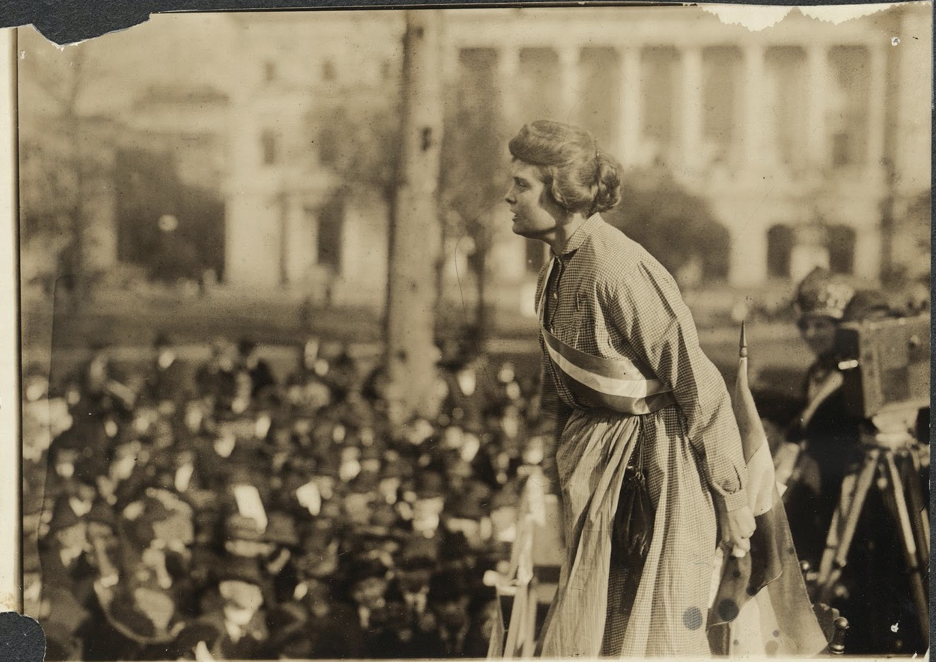by
_____
At age 16, she stumped for women’s suffrage at a boxing match.
One of her mother’s friends had spotted her early talent for oratory and recruited her for the movement. In October 1911, at the Long Acre Athletic Club in Manhattan, more than a hundred suffragists and male spectators converged for a night of boxing and wrestling matches — and suffrage speeches.
The highlight of the evening was the rousing ringside speech by Dorothy Frooks, America’s youngest suffragist.
Today we celebrate the centenary of the 19th Amendment — when women in the US won the vote. We honor the many thousands of women who advanced the suffrage cause. They marched, they protested, they negotiated and strategized. They went on hunger strikes. They were spit upon and beaten.
Through it all, they spoke.
In convention halls and at county fairs, in courtrooms and on street corners, in church basements, and even at a boxing match, they stepped up and used the power of the spoken word to advance their cause.
At convention halls and county fairs, in courtrooms, on street corners, in church basements, and even at a boxing match, they stepped up and used the power of the spoken word.
As we celebrate today, let’s pay tribute to the many thousands of women who spoke out for suffrage.
Female public speakers, especially those espousing radical ideas like women’s rights, faced tremendous opposition. They were belittled and called names. They were pelted with rotten vegetables. Nevertheless, they spoke.
In my online archive, the Speaking While Female Speech Bank, you’ll find more than 100 speeches by U.S. suffragists — black women, white women, Asian-American women, hispanic and indigenous women — the largest collection of suffrage speeches anywhere.
Among the earliest is the remarkable “Discourse on Women,” delivered in 1849 in Philadelphia by one of the earliest suffragists, Lucretia Mott.
Mott conceived of the idea of reforming the straitened position of women in society when she attended the General Anti-Slavery Convention in 1840 in London and was forbidden to speak.
“There is nothing of greater importance to the well-being of society at large — of man as well as woman — than the true and proper position of woman,” Mott told her audience nine years later in Philadelphia.
That was considered an extreme, outlandish idea at the time — and exposed her to ridicule. In 1850, her speech was published as a pamphlet and remains one of the foundational texts of the woman’s movement.
Two decades later, in 1867, at the Church of the Puritans in Manhattan, the brilliant women’s rights and abolitionist orator Sojourner Truth stepped up to the platform at the American Equal Rights Association.
In a speech known as “I Want to Keep Things Stirring,” she told the men in the audience: “You have been having our rights so long, that you think, like a slaveholder, that you own us. I know that it is hard for one who has held the reins for so long to give up.”
After her talk, Sojourner Truth broke out in song with a verse of the spiritual “Going Home” — singing was another way she used her voice.
Two years later, the abolitionist and women’s rights orator Anna Dickinson — wildly popular during the Civil War years — debated the well-known Methodist minister Robert Laird Collier, point by point, at the Chicago Woman Suffrage Association.
“Let us allow,” she said, “from one end of this country to the other, every man and woman, black and white, to go to the polls to defend their own rights and the rights of their homes.”
“Let us allow, from one end of this country to the other, every man and woman, black and white, to go to the polls to defend their own rights and the rights of their homes.”
In 1912, the fiery speaker Leonora O’Reilly delivered not one but two suffrage speeches to US congressmen on the same day — part of a women’s delegation mocked by The Washington Post as “a crusade in skirts.”
First, she testified before the House Judiciary Committee, accusing the congressmen of selling out working-class women. Then, while the hearing was still in progress, O’Reilly sped from the north to the south side of the Capitol building to speak before a Senate committee. “You men do not care,” she chided the senators. “You want this country to get rich, and you do not know the only riches of a nation are its people.”
Then there was the striking Inez Milholland, a powerful speaker and a martyr to the cause. In October 1916, while delivering an impassioned suffrage speech at Blanchard Hall in San Francisco, she collapsed and was carried off to the hospital, where she later died.
Her final words — “How long, Mr. President, must women wait for liberty?” — became the slogan for the National Woman’s Party picketers, who stood silently in front of the White House for 13 months, pressuring Woodrow Wilson to change his mind and support suffrage.
For each one these women who spoke out, there were dozens more. Some of their names and words we remember, but most have been forgotten.
In the history books, some voices get championed — others not.
Many of the suffragists’ speeches were not recorded or transcribed because the gatekeepers of their age — the newspaper reporters, magazine editors, and publishers — did not think they were worthy. They did not value what women had to say.
The speeches in the Speaking While Female Speech Bank represent only a small fraction of the many thousands delivered by American women fighting through the decades for the right to vote. Many more are hidden away in archives and old manuscripts, out-of-print books and newspapers, waiting to be rediscovered.
For today, on this jubilant historic day, let’s remember and celebrate women’s speech — because women’s voices matter.
© Copyright 2020
________________________________
Want to talk? Reach me at dana@danarubin.com



